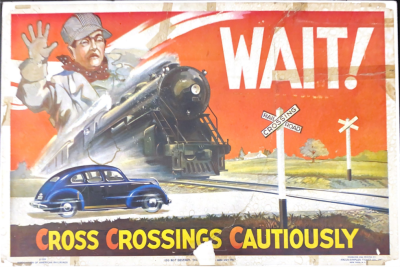There it is… The dreaded lights and gates coming down at a rail crossing. The agonizingly long wait for a mile-long freight train to crawl through. Thankfully, the Museum’s train is not that long, instead usually only one locomotive and three to four passenger coaches. Still, drivers get impatient and it does not always end well for the driver.

Rail Safety Poster issued by the Association of American Railroads in 1939 from the Museum’s Library & Archive collection. 2010.031.582
Trains, even trains as small and comparably lightweight as the Museum’s, take a long time to stop. Stopping distance depends on the weight of the train and the speed at which it is traveling. The Northwest Railway Museum’s train set only travels at about 5-10 MPH when moving through a crossing but can still take 40 feet to come to a full stop. That is a long distance to travel if you are a motorist realizing the consequences of a very bad decision. The Museum knows this from experience. Luckily for everyone, no one was seriously injured.
The majority of accidents around railway crossings, including the one mentioned above, occur when someone tries to beat the train by driving through or around the gate. The train is always going to win in a collision. The gate protects drivers by keeping them away from the tracks. The stripes painted on the road are another line of safety that protects cars from a gate coming down on top of them. Always remember to stop before you cross that line!
Nobody likes to be stopped in traffic, but there is a silver lining waiting for the Museum’s train to pass: There are always lots of smiling faces in the windows eager to wave to you!

